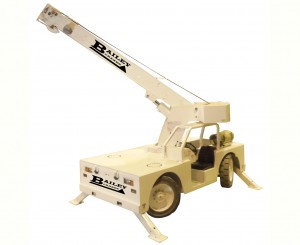Fuel costs continue to escalate for construction and industrial equipment owners, and to help increase fuel savings, Crane & Rigging Hot Line reports Bailey Cranes has rolled out a new line of battery- and hybrid-powered carry-deck cranes. The 18,000-lb. capacity IC-18 is the first in a line of four industrial crane models that Bailey Cranes plans to produce. The family of cranes will range in capacity from 9,000 to 36,000 lbs.
Bailey Cranes LLC is a two-year-old company headed by Jeff Bailey, former owner of Man Lift Engineering, Cudahy, Wis. It operates a 23,000-sq.-ft. factory in Milwaukee, where the firm designs, fabricates, and assembles its products. Key features of its carry-deck crane line are its environmentally friendly, quiet, and continuous operation.
“Heavy lifting, structural analysis, and implementing the latest in control technology has always been a passion for me,” says Bailey, president and CEO. “The crane industry is ripe for fresh ideas with a 20th-century upgrade to provide clean, quiet and safe lifting solutions.”
Exhaust-free operation
Bailey Cranes are primarily used indoors, where exhaust emissions and carbon monoxide poisoning are concerns. Bailey says the company’s battery-powered products are ideal for applications requiring exhaust-free operation, such as in clean rooms, refineries, aircraft or aerospace plants, industrial plants, mining, congested work areas, and the food industry. Bailey says the hybrid option allows for continuous operation and is ideal for machinery movers, rental companies, industrial plants, construction companies, and similar applications.
“Not just cars are moving to hybrid technology. Industrial and construction equipment have migrated to this power source, including Caterpillar’s hybrid excavator and Oshkosh’s Propulse heavy truck system,” Bailey says. Machines using hybrid technology are expected to provide such great fuel economy that the technology will pay back its owners in as little as one year of use.
All four models of Bailey Cranes, which will include the IC-9, IC-18, IC-30, and IC-36 when the product line is complete, will be available with either 80V battery power as standard or a hybrid-power option. Both the battery-powered and hybrid designs leave a small carbon footprint, and they meet strict EPA air-quality standards for operation in California.
The hybrid power system uses a “series” hybrid technology system—the system originated by Porsche and used by cars like the Chevy Volt. It consists of electric traction motors powered by a large battery. Battery power provides emission-free and quiet operation, and can be recharged by the standard 240V or 480V charger. On fully charged batteries, the IC-18 will run for six hours of hard use or 10 hours of normal use.
For continuous operation, a propane/gas or diesel engine coupled to an 80V generator provides power. According to Bailey, the engine needs to be only one-third the size of a typical machine’s because it runs continuously while the battery handles up-and-down power demands.
“The crane industry has been slow to adopt this technology, but once the benefits of hybrid technology are realized—fuel savings, low emissions, and quiet operation—crane owners will find equipment with this type of power a boon to their bottom line,” Bailey says.
IC-18 Details
The first model produced at Bailey’s plant is the IC-18, which offers 18,000-lb. lifting capacity on outriggers and 11,700-lb. pick-and-carry capability. The crane has a three-section, full-power, telescopic boom that extends and retracts with two hydraulic cylinders. The boom offers a maximum tip height of 37’5″ and a maximum load radius of 30 ft. An optional 10-ft. boom extension increases the maximum tip height to 46 ft. and the maximum radius to 40 ft. Boom tip options include a powered articulating jib, powered rotator, pallet forks, and grabbers/manipulators.
The two-wheel-drive travel system is powered electrically by two AC motors that are driven directly by the batteries. “We chose the AC electric travel system for its performance, responsiveness, controllability, and low maintenance,” Bailey says. The system uses regenerative braking to help recharge the batteries. For maximum maneuverability, the IC-18 comes standard with hydraulically powered, four-wheel steering.
The operator’s cab is similar to those used by other carry-deck crane manufacturers, according to Bailey, so operators will find it familiar and easy to work in. The function controls are fully proportional for excellent control and productivity.
Options on the crane include a radio remote control for operating the crane from outside the cab, non-marking tires to eliminate tire tracks on the floor, and omni-directional steering. For hazardous locations, the IC-18 can be developed to meet EE or EX standard ratings, as well as fitted with a 46KV insulated jib.
Author; Unknown
Source:


